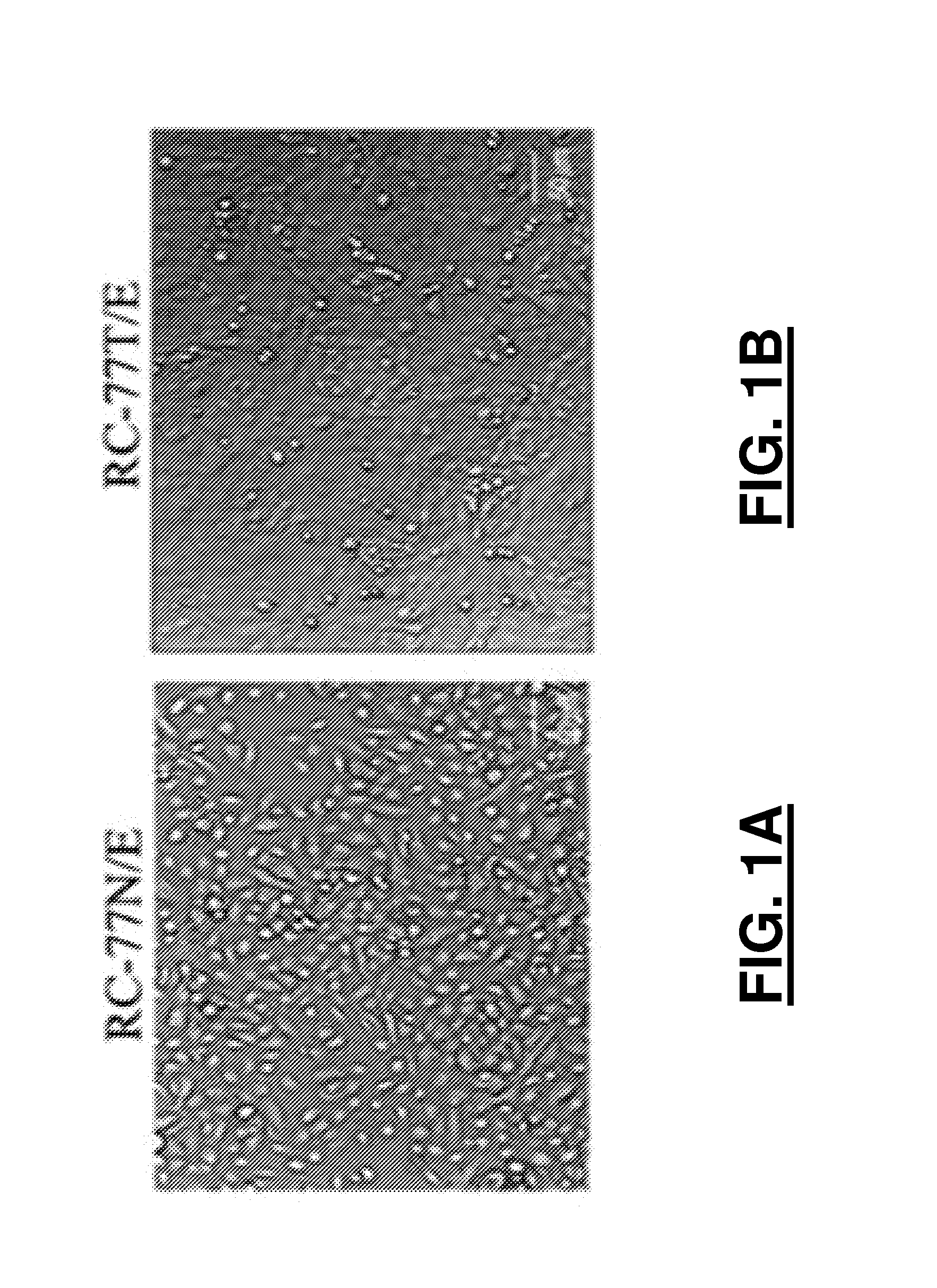Immortalized human prostate cell lines
a human prostate and cell line technology, applied in artificial cell constructs, biochemistry apparatus and processes, instruments, etc., can solve the problems of inability to accurately reflect the in situ characteristics of malignant epithelium for the study of african cancer, few treatment options, and ineffective anti-prostate cancer treatment options, etc., to achieve low toxic
- Summary
- Abstract
- Description
- Claims
- Application Information
AI Technical Summary
Benefits of technology
Problems solved by technology
Method used
Image
Examples
experiment 1
[0051]The morphological characteristics of the RC-77T / E and RC-77N / E cell lines were studied via microscope. As depicted by the comparative black and white photographs of FIG. 1A and FIG. 1B. the RC-77N / E and RC-77T / E cells, respectively, exhibit typical epithelial morphology, with the cells growing as adherent cells with some being more piled-up on each other in certain areas.
experiment 2
[0052]In order to genetically characterize the two newly created cell lines RC-77T / E and RC-77N / E, a RT-PCR assay was done according to the procedure described by Xu et al. (“Expression profile of an androgen regulated prostate specific homobox gene NKX3.1 in primary prostate cancer.” J Urol 163: 972-979, 2000.). Total RNAs from culture cells were extracted with RNAzol B (obtained from TEL-TEST Inc., Friedswood, Tex.) according to the manufacturer's protocol and quantified with a Nucleic Acid Quantitation Kit (obtained from NBI, Plymouth, Minn.). Total RNA (1 μg) was reverse transcribed into cDNA with an RNA PCR kit (obtained from Perkin-Elmer, Foster, Calif.), and 1 / 10 of the reverse-transcribed product from each sample was used for PCR to amplify AR, NKX3.1, CK8, and HPV-16E6 genes respectively. The expression of CK8 was used as an internal control for input RNA as well as the marker for epithelial cells. To verify the validity of CK8 as the internal control, CK8 was compared with...
experiment 3
[0055]Since androgen receptor expression was observed both cell lines, an experiment was conducted to determine the effects of androgen stimulation on the growth of RC-77N / E and RC-77T / E cells. Cells were grown in serum-free K-SFM at different doses of Methyltrienolone (R1881), a synthetic androgen, for 4 days.
[0056]In this experiment, 2×104 cells per well of each line were grown in serum-free K-SFM with 0.1% BSA in the presence of 0, 0.1, 1.0, 10.0 and 100.0 nM for 4 days. K-SFM was supplemented with or without Methyltrienolone (R1881) (obtained from Perkin-Elmer, Waltham, Mass.), at concentrations of 0.1, 1, 10 and 100 nM, respectively. Cell proliferation was determined by MTT assay according to a procedure as generally described by Wells et al. (“Luteinizing hormone-releasing hormone agonist limits DU-145 prostate cancer growth by attenuating epidermal growth factor receptor signaling.” Clin. Cancer Res. 8: 1251-1257, 2002.).
[0057]The results from this experiment are illustrated ...
PUM
| Property | Measurement | Unit |
|---|---|---|
| time | aaaaa | aaaaa |
| size | aaaaa | aaaaa |
| concentration | aaaaa | aaaaa |
Abstract
Description
Claims
Application Information
 Login to View More
Login to View More - R&D
- Intellectual Property
- Life Sciences
- Materials
- Tech Scout
- Unparalleled Data Quality
- Higher Quality Content
- 60% Fewer Hallucinations
Browse by: Latest US Patents, China's latest patents, Technical Efficacy Thesaurus, Application Domain, Technology Topic, Popular Technical Reports.
© 2025 PatSnap. All rights reserved.Legal|Privacy policy|Modern Slavery Act Transparency Statement|Sitemap|About US| Contact US: help@patsnap.com



